

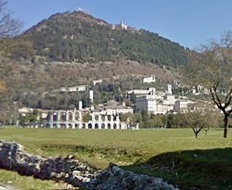
The archaeological area outside Porta degli Ortacci, in the area known as Guastuglia, extends across some 25 acres bounded by Viale del Teatro Romano, Via Matteotti, Viale Parruccini, Via Ubaldi and Via Perugina. A stretch of Roman wall (2nd century BC) that is visible to the southwest of the theatre (in the foreground in this photograph) seems to have supported the terrace on which Roman Iguvium was built.
The area was fully developed in the following century, and became surrounded by a ring of necropoles. It was in continuous use until at least the 4th century AD. It was finally destroyed in 552 by Totila. (The city was subsequently rebuilt on the present site higher up the mountain, which was also probably the site of the original Umbrian settlement of Ikuvina.)
The most obvious area of interest is the Roman theatre (below). The important Iguvine Tables (late 3rd - early 1st century BC, now in the Museo Civico) were apparently discovered in an underground room here in 1444.
Itinerary
Tickets to the site are available in the Antiquarium, which is housed in the medieval house in Via del Teatro Romano. Excavations under it unearthed a Roman domus (1st century BC) that was in use until the 2nd century AD. Mosaics from this domus are displayed, together with a number of archeological exhibits that illuminate the history of the city in pre-Roman and Roman times.
The signed itinerary around the archeological area includes:
-
✴the Antiquarium itself;
-
✴the Roman theatre, which is the star attraction;
-
✴the mausoleum of Lucius Pomponius Grecinus; and
-
✴the wider archeological area of la Guastuglia.
Other excavations of Roman Iguvium that have been carried out near Porta degli Ortacci (on the opposite side of Viale del Teatro Romano ) have unearthed the Roman baths (below), together with a broadly contemporary domus. These structures marked the first stages of the expansion of the city into the plain to the south in the 2nd century BC, as the Romans began the construction of the city of Iguvium.
Roman Baths (1st century BC)
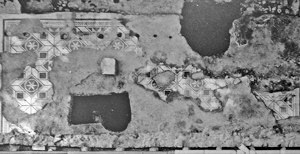
Floor of a room in the Roman baths, from a photograph displayed in the Antiquarium
The area inside Porta degli Ortacci was excavated in ca. 1749, just prior to the construction of the Ospedale Grande. Further excavation was possible for a short period during roadwork in Via degli Ortacci in 1928, and more systematic excavations were carried out here in the 1980s.
Finds made at the lower levels included the remains of many rooms from a building that probably formed part of theRoman baths. These rooms included two apsidal thermal areas and a central room with a black and white patterned mosaic floor (illustrated above).
Some ceramics found during the excavation of this site are exhibited in the Antiquarium.
Roman Theatre (1st century BC)

Fragments of an Inscription (44 - 27 BC)

Six fragments in the Museo Civico that were found in the theatre probably came from the same inscription (CIL XI 5828), which probably commemorated the dedication of the theatre in the triumviral period.
Gnaeus Satrius Rufus (late 1st century BC)


Found in the 16th century Found in 1863
These two inscriptions (CIL XI 5820), which were found in the Roman theatre (one in the 16th century and the other in 1863), seem to have carried identical texts, although the second is more complete. They record the civic works of Gnaeus Satrius Rufus, a quattuorvir iure ducundo of Iguvium in the late 1st century BC. Apparently, Rufus made a number of bequests for (inter alia):
-
✴the roofing of the basilica (foyer) of the theatre and the paving of the floors of two of its rooms;
-
✴the renovation of a temple to Diana; and
-
✴the victory games held in honour of the Emperor Augustus.
These inscriptions are now in the Museo Civico.
Two inscriptions (CIL XI 5820) from the reign of the Emperor Augustus (27 BC – 14 AD) that were found nearby (one in the 16th century and one in 1863) record that Gnaeus Satrius Rufus roofed the basilica (foyer) of the theatre and paved the floors, probably as part of a major restoration. He also renovated a temple to Diana that might well have been part of the complex, and made a number of other donations for civic purposes including money to finance games held in honour of Augustus. These inscriptions are now in the Museo Civico.
A burnt layer containing late Roman coins suggests that the theatre was burned and abandoned in the late 4th century AD. The site served as a quarry for building materials. (The museum suggest that a mosaic of a lion fighting a tiger in Holkham Hall, Norfolk, which the family acquired in Rome in ca. 1772, might have been the mosaic of this subject that was discovered in the theatre in the 16th century). What survived of the structure was heavily restored in 1900, when the surrounding buildings were removed.
Today, only the lower of what were originally two levels of seating survives. This page of the website of the Soprintendenza per i Beni Archeologici dell'Umbria (which takes a little time to load) allows you to take a virtual tour around the structure.
Roman Mausoleum (1st century BC)

-
✴A local tradition claims that it was the sepulchre of Gentius, king of the Illyrians (died ca. 167 BC), who was (according to Livy) imprisoned in Gubbio after he surrendered to the Romans and after the people of Spoleto had refused the honour of imprisoning him.
-
✴Other sources name the occupant as Caius Pomponius Graecinus, son of Caius, who was probably the son of Caius Pomponius Graecinus, the suffect consul of 16 AD, on the grounds that an inscription (CIL XI 5809) bearing his name was found nearby in the 19th century. (This inscription is now in the Museo Civico).
There is unfortunately no evidence to support either hypothesis.
Guastuglia
Traces of ancient road that apparently crossed this area was found [when?], near the theatre and under Palazzo Vispi. [A paved stretch of it can be seen near the palace]. Another stretch of what seems to be the same road was unearthed in 2012, running along the portico of the newly-discovered Roman temple (below).
This road was interrupted by a monumental structure (probably a public building) under Palazzo Vispi, which might signify that this was the location of the forum. The excavations also unearthed the remains of the bases of pillars that probably formed part of a colonnaded along the road as it extended towards the theatre.
Temple (1st century AD)
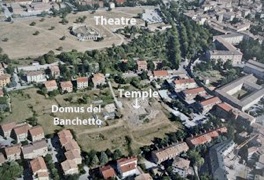
Aerial photograph showing the location of the temple
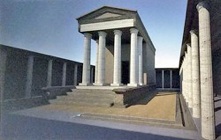
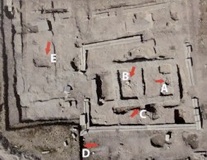
Reconstruction of the temple Votive deposits on the site (marked A-E)
All three illustrations are displayed in the Antiquarium
The foundations of this temple were discovered during excavations in 2001-10. It comprised a cella and pronaus on a podium (7.4 x 11.5 meters), facing southeast. Only the foundations (including those of the base of a statue at the centre of the back wall) and the remains of the podium survive. Finds from the site are exhibited in the Antiquarium.
A votive deposit in front of this statue (at A in the plan above), which was sealed by a double layer of stones and bricks, seems to have been used for animal sacrifice. According to the notes displayed in the Antiquarium, this sacrifice probably took place in the 1st century AD, at the time of the consecration of the temple. Four nearby pits also contained evidence of the sacrifice of animals: again according to the notes displayed in the Antiquarium, these sacrifices were probably associated with the abandonment of the sanctuary in the 4th century AD.
Domus del “Banchetto” (1st century BC)
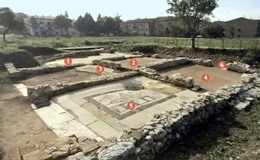
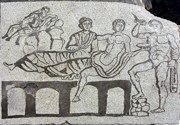
Photographs of the excavated site and the mosaic of the banquet,
both displayed in the Antiquarium
This is the most remarkable of a number of Roman houses that were excavated along Via Buozzi in 1970. Only seven rooms have in fact been excavated, and the layout of the entire structure has yet to be defined. It is known as the Domus del “Banchetto” (of the Banquet) because one of its rooms (room 5 in the photograph above) has a floor mosaic (ca.300 AD) that depicts two female figures (one of which is probably the Marine Venus) and of Bacchus pouring wine. On the left, a hunter is depicted, resting on rocks. This mosaic seems to have been part of a restoration of the villa that was carried out at that time.
Another five rooms with mosaic pavements have beed excavated. A fragment of mosaic decoration from a wall of one of them is exhibited in the Antiquarium.
Scarico di San Biagio
The so-called scarico di San Biagio was discovered along the stretch of Via Bruno Buozzi between Via Allende and Via Ubaldi in 1975. It contains a huge deposit of ceramics dated from the 4th to the late 2nd century BC [and a furnace ??]. It had not been formed in chronological layers, which suggests that it had been moved here from elsewhere. Since the hoard contains nothing that can be dated later than the late 2nd century BC, it seems likely that it was associated with earth moving during the urbanisation of the surrounding area at this time. Many of the finds are exhibited in the Museo Civico.
Read more:
L. Cencaioli et al., “Gubbio, la Domus di Scilla e il Parco Urbano: Uno Studio di Valorizzazione”, Bollettino di Archeologica Online 2011
S. Sisani, “Tuta Ikuvina: Sviluppo e Ideologia della Forma Urbana a Gubbio”, (2001) Rome
See also this page in the website of the Regione Umbria.
Return to Monuments of Gubbio.
Return to Walk II.

